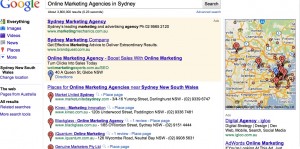I have been attending the Bruce Clay SEO Toolset Training in Sydney the last 3 days. Now that I am a wealth of information, I am trying to share some of it before it starts to leak out of my over-stuffed brain.
So one of the key tips that I learnt for successful website optimisation is the increasing need to start optimising for Google local search.
 Local search is a combination of standard webpage based geo-targeted search results (organic search results that match your keyword query) and a local search Google map with a red pin to identify the Google local search results.
Local search is a combination of standard webpage based geo-targeted search results (organic search results that match your keyword query) and a local search Google map with a red pin to identify the Google local search results.
So you would assume that the organic listings that show up (below the local search results and map) are the same as the local search map pins/listings that also appear, right? Not true.
The Google local search listings that show with the accompanying map are a sample of results generated from the Google local search feed. This feed is a combination of certified service feeds that Google uses to create the local search listings (Bruce Clay thinks 18 certified services in Australia, but needed to check. It was definitely 22 sites in the USA that Google accepts feeds from). Google relies on these local feeds for the address location, phone numbers, website urls and ratings and reviews. The Google local search results are influenced by the ratings and reviews in the feeds and the exact match of the address, phone number and url information. Therefore, to get ranked well in local search, you need to make sure you are listed in all 18 certified service provider with the exact same information and that you have a good number of ratings and reviews.
And sometimes, Google Places results also show up in the local search listings. Google Places are also based on registered listings and ratings & reviews.
So, are these organic results or not?
They’re mixed into the search results on page 1 of all Google search results. There are over 20 combinations of how the local search results may display on the search results page. Sometimes the map is on the right hand side (as you can see in the image above), and if there are no paid search listings, the map will scroll down the page as the user scrolls. If there are paid search listings, the map will stay stationary. Sometimes the map is on the left hand side, next to the local search listings.
I think the question as to whether local search results are organic or sponsored is a contentious one. I think we could go round and round in circles and the answer would change depending on which of the 20 variations show up in the search results.
And regardless of the local search feeds, if they are based on accurate information that matches in all 18 sites and the ratings and reviews are natural, then perhaps this is a strong argument that they are indeed organic. But what about when a paid pin shows in the local search map as a blue pin? This is a paid listing mixed with natural search listings. Does that change the result to be paid or just that 1 pin?
As you can see, I haven’t quite made up my mind. What do you think?

Trackbacks/Pingbacks